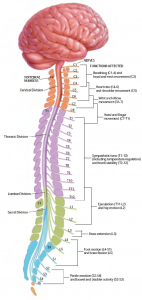Spinal Injury levels explained
The level of injury is the exact point in the spinal cord at which damage has occurred. The levels are determined by counting the nerves from the top of the neck downwards. These nerves are grouped into four different areas: Cervical, Thoracic, Lumbar and Sacral.

If you have injured the spinal cord in your neck you will have injured one of your cervical nerves (1-7). An injury like this would be referred to as C1, C2 etc. If you have injured the spinal cord in your back, you will have injured either Thoracic nerves (1-12) or lumbar nerves (1-5). A back injury would be referred to as T6, L1 etc.
Paraplegia:
Damage to the spinal cord in your back will result in paraplegia. This affects the movement and sensation in your legs and possibly some stomach muscles.
Tetraplegia:
Damage to the spinal cord in your neck will result in tetraplegia. Tetraplegia affects movement and sensation in all four limbs, as well as stomach and chest muscles.
Complete and Incomplete
After a complete neurological examination, the doctor will assign a level of injury and determine if the injury is complete or incomplete. The initial level of injury and function may also change upon discharge to rehabilitation.
Complete and Incomplete indicates the type of spinal cord injury you have sustained.
If you have some muscle function or sensation below your injury then your injury is incomplete. An incomplete injury means that the ability of the spinal cord to convey messages to or from the brain is not completely lost. Additionally, some sensation (even if it’s faint) and movement is possible below the level of injury.
If there is no movement or sensation from the injury level or below then your injury level is complete and is indicated by a total lack of sensory and motor function below the level of injury.
Next: Movement and Sensation - a closer look